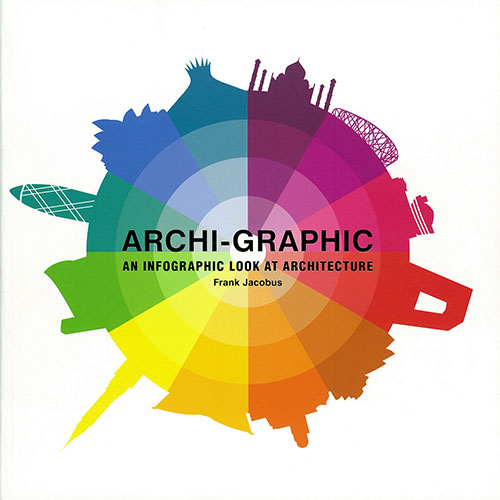
FAYETTEVILLE, Ark. — A new book features diagrams representing the current ethnic distribution of architects and color wheels depicting the different colors of architectural structures. There is even a playful image that shows famous architects distinguished by their facial hair or eyeglasses.
These are just a few of the creative and informational graphics included in the recently published book Archi-Graphic: An Infographic Look at Architecture by Frank Jacobus, an associate professor of architecture at the Fay Jones School of Architecture and Design at the University of Arkansas.
The book collects digital graphs and informational charts that creatively convey facts about architecture and architects. Jacobus describes the book as a "new way of looking at architecture," and he combines information with humor in a visually stimulating format.
He said that the book could act as a reintroduction into the history and discipline of architecture for those who have been out of design school for several years. It could also be suitable for someone who simply is interested and intrigued by the information and data associated with architecture.
The 150-plus-page book contains information that is formatted and visualized in myriad ways, such as constellations, bar codes, maps and more. The content ranges from diagrams about the countries in which architects did their main work, represented by an amalgamation of those countries' flags, to architectural facts about major cities digitalized into bar codes (in a skyline view) and a take on the nutritional facts label found on packaged foods.
One page, "Career Track," shows important dates for different architects in the form of a racetrack. Another spread shows famous quotes from architects presented structurally in the form of diagrammed sentences. The book also contains more light-hearted matter regarding the personal lives of famous architects, such as extramarital affairs by architects displayed through a subway map.
This new informational lens that looks at facts related to architecture and architects helps to convey the important facts in a more engaging way than traditional books, Jacobus said.
"The book gives you a lot of things that are visually stimulating that help draw you into the discipline," he said.
The two-year process for creating the book started when Jacobus realized that there were not any infographic books about architecture. He started creating sketches and had some of his students help digitize his ideas. Then, the process began flowing, when the students and Jacobus gathered on Friday nights around pizza, soda and buzzing ideas.
Jacobus would create the sketches, then the students would transform them into digital form. After that, Jacobus would begin critiquing and editing the drawings. Jacobus said that he was divorced from the digitalization process, which was helpful because when he would get back the digital form of his sketch, he would be so removed from it that he would be able to edit the picture more objectively.
"It was a pretty open process. Everyone would volunteer information about how it could be better," Jacobus said.
As the students showed Jacobus their digital work, he got a thrill seeing his rough sketch translated into a beautiful format. After they had created 20 to 30 sketches, Jacobus pitched the book to different publishers, finally settling on Laurence King Publishing.
Looking back at the process and creation of the book, Jacobus feels that his time with the students was the most beneficial part of his journey.
"I think I will look back at this in five years, and what I will see as most special are those relationships with the students," Jacobus said. "Working with students and sharing ideas: that is why I teach."
He hopes that his book will intrigue people to learn about architecture and will function as a "mechanism to draw laypeople in to the discipline."
Though students can use the book as a tool for learning about architecture and how to communicate information visually, that is not the ultimate goal of the project. While it has an educational value, it also can simply be a pleasure for readers to experience.
"The main objective is to make something beautiful that people enjoy," Jacobus said.
Jacobus is currently working on another book about color with a similar style and context.
Contacts
Leigha Van Sickle, communications intern
Fay Jones School of Architecture and Design
479-575-4704, ljvansic@uark.edu
Michelle Parks, director of communications
Fay Jones School of Architecture and Design
479-575-4704, mparks17@uark.edu